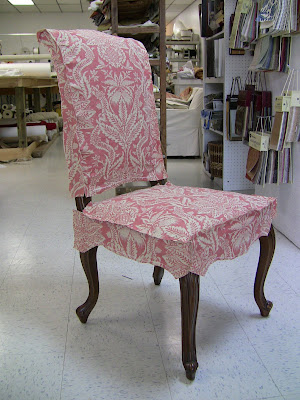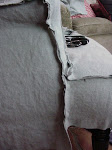Wednesday, May 26, 2010
French dining chairs
This chair is all curves. In order to fit the chair smoothly the cover has to have a flat piece at the sides of the back and also for the apron around the seat. The apron is cut to match the curves on the bottom of the chair with an extra one inch of length to make sure that it covers the wood.
here is a close-up of the seat. The apron has to extend around to the back to attach with hook & loop fasteners. Since the fabric is patterned there will not be any extra buttons or trims except for a flat welt in all of the seams.
Saturday, May 22, 2010
what's wrong with these cushions?
These are nice cushions, and the quilted fabric is luxurious and comfortable, even though the cord is worn through in places.

BUT .......
The cord on these cushions has a jute core, such as upholsterers use. It has worn out the cording from the inside, since the cord was covered with a lightweight chintz fabric.
If you cover your welt cord with fabric cut in the direction of the grain of your fabric it will always be "wavy" like this. Use bias strips (preferably cut at true bias, or 45 degrees) and join them with seams that are diagonal instead of straight across the cord. Free instructions for cutting continuous welt cord can be found here
Wednesday, May 19, 2010
Does my wing chair have a "telephone arm?"
Here's a seminar attendee with her wing chair cover. You may notice that the arm front panel stops at the level of the cushion and is corded all the way around. Since this piece is shaped like a 1950's-style telephone receiver, I call this a "telephone arm."
If you order my wing chair DVD and book be sure to let me know if you have this type of arm on your wing chair and I will include instructions for this variation.
Using multiple fabrics for a slipcover
This sofa cover was made for a restaurant waiting room in Dallas. There are five fabrics involved, including the polka dots for the back cushions and the cording, made from black and white striped fabric cut on the bias. This would also be good done in small-scale prints and stripes in mixed colors.
If you have done a multi-fabric cover, please send us a photo and some comments if you have time.
love, Pat
Friday, May 14, 2010
Scalamandre is having a sale!!!
Scalamandre, which is only the highest-end house for silk fabrics and trims, is having a sale!!! http://www.scalamandre.com is where you can find terrific discounts right now. The buzz is that this years-old company is in new hands, and we all know that means bargains on current stock.
Here's a cover I made for an ordinary folding chair.With silk fabric and trim it sure looks uptown, doesn't it?
Here's a cover I made for an ordinary folding chair.With silk fabric and trim it sure looks uptown, doesn't it?
Wednesday, May 12, 2010
Chair with front arm broken?
This post goes with a shout-out to Donna Berglin, my former intern who is now living and working in Portland, Oregon. I miss you and your smiling face, Donna!!!


We did a set of three covers for this furniture. Guess which piece had a front arm broken off? You can't.
After the chair cover was cut, we copied it for both pieces, and stuffed the cover with dacron where the broken arm was.
Voila!!! it was the chair on the right in the first picture. Only the chair owner (and us) would ever know. Not rocket science, I guess, but I was pretty proud of our near solution to the problem.
Tuesday, May 11, 2010
Slipcover with Dressmaker Skirt
This tone-on-tone gray cover is trimmed with a ribbon-style trim. Usually I cut slipcovers in the customer's home, but for this style the piece has to be brought in to the shop.
I make the entire cover with extra length on the skirt (including pleat inserts) and then with the cover on the chair I mark and pin the hemline. This is why I call this style "dressmaker skirt"
The flat welt in the seams is another way to personalize the cover. Corners of the cushion have little pleats to make the flat welt go around corners well. This style is the only time I cut strips on the straight grain of the fabric. Any other time I use bias-covered welt.
I make the entire cover with extra length on the skirt (including pleat inserts) and then with the cover on the chair I mark and pin the hemline. This is why I call this style "dressmaker skirt"
The flat welt in the seams is another way to personalize the cover. Corners of the cushion have little pleats to make the flat welt go around corners well. This style is the only time I cut strips on the straight grain of the fabric. Any other time I use bias-covered welt.
Monogrammed dining chairs in white linen
This dining chair with arms has a monogram and a box pleated skirt. Box pleats spaced so that a pleat falls on each front corner. White linen cover with 1/4" cordless welt in the seams.
The closings are actually hook and loop fastener, sewn in, with 3/8" covered buttons applied on the outside.
ten side chairs are exactly same style, without arms and front arm openings.
The closings are actually hook and loop fastener, sewn in, with 3/8" covered buttons applied on the outside.
ten side chairs are exactly same style, without arms and front arm openings.
Friday, May 7, 2010
Altering Ready-Mades
Assuming, of course, that you can find fabric that you like,one way to go if you can't afford custom and don't want to sew a cover is to buy one ready-made and alter it.
First, check the measurements of your sofa or chair (length from front to back, side to side, and top to floor) and then go shopping. Internet preferred, of course, since we all want to save gas. Check the measurements of the ready-made cover to be sure it is at least as large as your measurements and possibly a little over.
When you get it home, put the cover on the chair or sofa, take a good look, and decide if you want it smaller somewhere. Do the same thing with the cushion cover(s). If there is cord in the seams, you will have to open them at this point. Turn the cover wrong side out and pin the seams that need taking in. Do it with large stitches first, so you can tweak the fit if you need to.
Note: if you want to do this by hand, just be sure that you make "back-stitches" every inch or so, to keep the stitches from pulling out under stress. Sew the seams with LARGE machine stitches at first.
After you have a good fit, replace the cord in the seams if there is any, re-sew and trim the seams. Serge them, if possible. Most ready-made slips are in less than wonderful fabric, and you don't want any fraying in the washing machine. Some people even bind the seams by putting strips of bias tape or something like it over the seams.
If this system works for you, please send us a picture of your results. Wing chairs are the hardest, but if you Google "wing chair slipcovers" you will be surprised how many sources you find!!!
First, check the measurements of your sofa or chair (length from front to back, side to side, and top to floor) and then go shopping. Internet preferred, of course, since we all want to save gas. Check the measurements of the ready-made cover to be sure it is at least as large as your measurements and possibly a little over.
When you get it home, put the cover on the chair or sofa, take a good look, and decide if you want it smaller somewhere. Do the same thing with the cushion cover(s). If there is cord in the seams, you will have to open them at this point. Turn the cover wrong side out and pin the seams that need taking in. Do it with large stitches first, so you can tweak the fit if you need to.
Note: if you want to do this by hand, just be sure that you make "back-stitches" every inch or so, to keep the stitches from pulling out under stress. Sew the seams with LARGE machine stitches at first.
After you have a good fit, replace the cord in the seams if there is any, re-sew and trim the seams. Serge them, if possible. Most ready-made slips are in less than wonderful fabric, and you don't want any fraying in the washing machine. Some people even bind the seams by putting strips of bias tape or something like it over the seams.
If this system works for you, please send us a picture of your results. Wing chairs are the hardest, but if you Google "wing chair slipcovers" you will be surprised how many sources you find!!!
Thursday, May 6, 2010
Welcome to Slipcover University
Just a little blog for people with slipcovers on the brain, like me.
I hope to hear from folks who are using a Slipcover University DVD or book. I just sent a package to Dede O'Hair, a veteran of one of my classes at the Slipcover Summit. She turned up last week on the Workroom Association of America newsgroup.
I hope to hear from folks who are using a Slipcover University DVD or book. I just sent a package to Dede O'Hair, a veteran of one of my classes at the Slipcover Summit. She turned up last week on the Workroom Association of America newsgroup.
Or maybe we will hear soon from Carolyn Bentley, in Hamilton, GA. Carolyn plans to cover a sofa with two seat and two back cushions. She sent photos and measurements; I made up a custom kit of instructions with lots of pictures to show her how to cut and assemble her cover. With this and the cushion DVD she is all set to start a new look in her family room!!!
. There are lots of slipcover instructions and patterns out there. You can find them in fabric stores, as well as online. If you find something that is more complete or easily followed than the SCU items, I will send back your money so soon it will make your eyes water.
In the meantime, please take a look at the SCU catalog. Even if you aren't planning to make your own covers, you might find some terrific ideas, like the monogrammed dining chairs, or my new custom made patterns. For instance, make a folding chair look like a million bucks$$$...
.
Subscribe to:
Posts (Atom)













